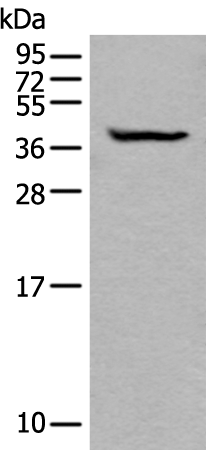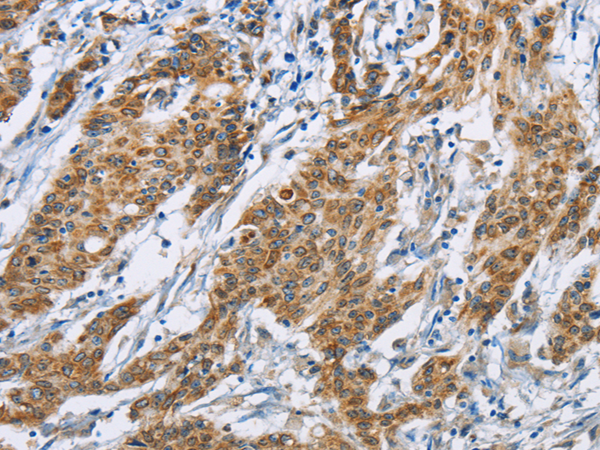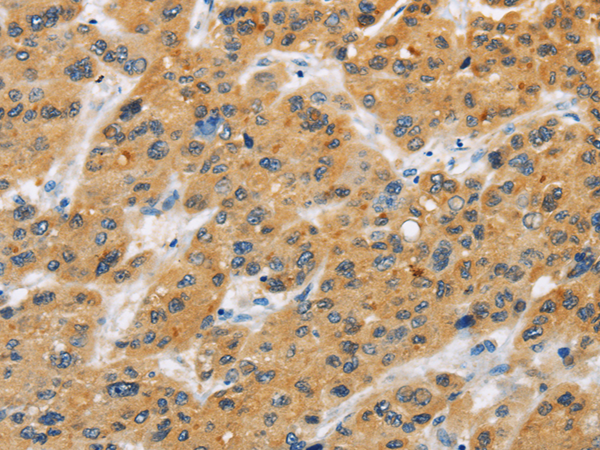


| WB | 咨询技术 | Human,Mouse,Rat |
| IF | 咨询技术 | Human,Mouse,Rat |
| IHC | 1/25-1/100 | Human,Mouse,Rat |
| ICC | 技术咨询 | Human,Mouse,Rat |
| FCM | 咨询技术 | Human,Mouse,Rat |
| Elisa | 1/5000-1/10000 | Human,Mouse,Rat |
| Aliases | BTLA1; CD272 |
| WB Predicted band size | 33 kDa |
| Host/Isotype | Rabbit IgG |
| Antibody Type | Primary antibody |
| Storage | Store at 4°C short term. Aliquot and store at -20°C long term. Avoid freeze/thaw cycles. |
| Species Reactivity | Human |
| Immunogen | Fusion protein of human BTLA |
| Formulation | Purified antibody in PBS with 0.05% sodium azide and 50% glycerol. |
+ +
以下是关于BTLA抗体的3篇参考文献示例:
1. **《BTLA-HVEM结构互作调控T细胞功能的机制研究》**
作者:Ware, C.F.等
摘要:该研究解析了BTLA与HVEM结合的晶体结构,揭示了其抑制T细胞活化的分子机制,为设计靶向BTLA的抗体药物提供了结构基础。
2. **《抗BTLA单克隆抗体增强抗肿瘤免疫反应的临床前评估》**
作者:Murphy, T.L.等
摘要:通过小鼠模型证明,阻断BTLA信号可增强CD8+ T细胞活性,抑制肿瘤生长,提示BTLA抗体在癌症免疫治疗中的潜在应用价值。
3. **《BTLA抗体在自身免疫性疾病中的双重调节作用》**
作者:Gavrieli, M.等
摘要:研究发现BTLA抗体可通过调节Th17/Treg平衡缓解类风湿性关节炎症状,但也可能过度激活免疫系统,强调治疗需精准剂量控制。
注:上述文献为示例,实际引用时请核对真实存在的论文信息。
BTLA (B and T Lymphocyte Attenuator) is a co-inhibitory receptor primarily expressed on B cells, T cells, and dendritic cells. Discovered in 2003. it belongs to the CD28 immunoglobulin superfamily and shares structural homology with PD-1 and CTLA-4. BTLA interacts with its ligand HVEM (Herpesvirus Entry Mediator), generating inhibitory signals that dampen immune activation. This pathway plays a critical role in maintaining immune homeostasis by preventing excessive responses to antigens, but it can also contribute to immune evasion in cancers and chronic infections.
Research on BTLA antibodies focuses on modulating this pathway for therapeutic purposes. Agonistic antibodies that enhance BTLA signaling are explored for treating autoimmune diseases and graft-versus-host disease by suppressing hyperactive immunity. Conversely, antagonistic antibodies blocking BTLA-HVEM interactions aim to restore anti-tumor immunity, particularly in "immune-excluded" tumors resistant to PD-1/PD-L1 inhibitors. Preclinical studies demonstrate synergistic effects when combining BTLA blockade with PD-1 inhibitors, suggesting potential for combination therapies.
Clinical development remains early-stage, with several BTLA-targeting antibodies entering phase I/II trials since 2020. Challenges include optimizing antibody specificity and understanding context-dependent roles of BTLA across different malignancies. As an emerging immune checkpoint, BTLA represents a promising but complex target for next-generation immunotherapy.
×